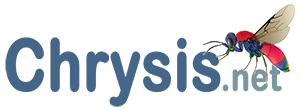Last updated on June 9th, 2020
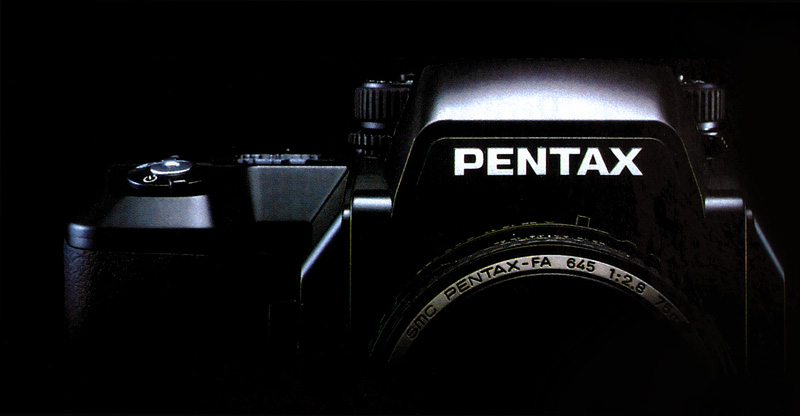
Pentax 645N: overview
In 1984, PENTAX first introduced the PENTAX 645, an epoch-making camera, to field photographers. Despite its medium-format design, it handled superbly and soon became the favorite of
Now PENTAX introduces the 645N, a new medium-format SLR that combines the proud tradition and technological excellence of the 645 with a host of new features, including a high-precision AUTOFOCUS system, to make it even more maneuverable and responsive in the field.


Autofocus
The 645N incorporates the PENTAX-developed SAFOX IV phase-matching autofocus system to ensure accurate focusing not only on subjects with vertical orientation but also on those with horizontal orientation . – even under such poor lighting conditions as EV-1. The choice of the wider “3-Point AF” frame and the pinpoint “Spot AF” frame allows the photographer to use the most suitable focus frame for each subject and in every situation. The 645N offers three focus modes to choose from: “AF Single” activates the shutter only when the subject comes into focus; “AF Servo” lets the user release the shutter at any time. Manual Focus lets the user adjust the focus manually using the focus ring on the lens. In the manual-focus mode the focus indicator in the viewfinder provides the focus status. In the AF Servo mode, the 645N’s AF system detects the subject’s movement (toward or away from the camera) and “predicts” the optimum focusing point at shutter release for pinpoint focus on the subject on the move.
 Data print
Data print
To keep accurate track of photographic data, the 645N lets the user imprint valuable data (exposure frame number, exposure mode, shutter speed, aperture, exposure compensation value, metering mode and lens focal length) at the bottom of the film just outside the image area.
Exposure
The 645N incorporates a newly developed Dual Six-Segment multi-pattern metering system. Two sensors positioned at both sides of the viewfinder measure the subject’s lighting condition in two different areas: the wide sensor covers the entire image field, while the narrow sensor monitors the light reaching the central area of the image field. As a result, the 645N can measure the subject’s lighting condition with exceptional accuracy and efficiency. In addition to the Dual Six-Segment metering, the 645N also offers the pinpoint Spot Metering and conventional Center-Weighted Metering modes. The 645N’s four distinctive exposure modes allow the user to react effortlessly and efficiently to every situation and create the desired visual effect with ease: Programmed AE for adjustment-free shooting; “Aperture-Priority AE” to emphasize the depth of field; “Shutter-Priority AE” for sports and action photography; and “Metered Manual” for maximum control over exposure settings.
Motor
A built-in motor drive advances the film at the speed of 2.0 frames per second. Thanks to the high-precision pulse-count film transport mechanism, the spacing between frames is identical and the number of frames which can be taken from one roll of film has been increased from the 645 (16 frames from 120 film and 33 frames from 220 film). This motor drive also offers two film advance modes: “Single Advance” to advance one frame for each shutter release and “Consecutive Advance” to successively advance the film as long as the shutter release button is depressed. In addition, the motor drive automatically loads the film and advances it to the first frame, and winds the film into the film holder to avoid accidental exposure during film changes.
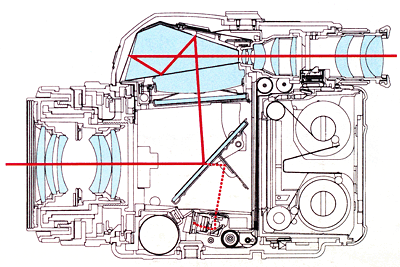
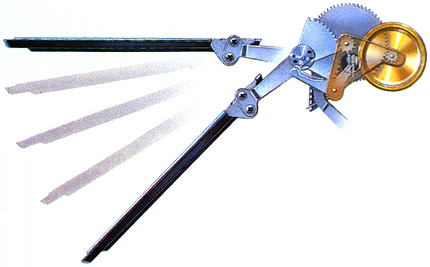
Viewfinder and panels
The 645N’s viewfinder eyepiece comes equipped with a built-in diopter adjuster to adjust the viewfinder image for near- and far-sightedness within a range between -3.5 and +1 diopters. The 645N incorporates an acclaimed Natural-Bright-Matte focusing screen to provide a sharp, bright viewfinder image. In addition to the standard Center Spot Matte screen, the photographer can also select the AF Split-Image, AF Microprism or Cross-Lined Matte screen.Located at the camera’s right shoulder, the LCD data panel provides the photographer with useful operational data at a glance in easy-to-understand letters, digits and symbols. An LCD data panel located at the bottom of the viewfinder indicates a full range of photographic data. Its bar-graph indicator is especially useful for checking exposure status in the metered Manual mode.
Rigid body
The 645N’s body is made of rigid aluminum and protected with a glass-fiber-reinforced polycarbonate coating approximately 1.7 times thicker than a normal coating. As a result, the 645N is extremely durable and resistant to shock and wear. In addition, special mechanisms are incorporated in the 645N to ensure low-noise, low-shock operation – particularly important features in wildlife photography.
Other features
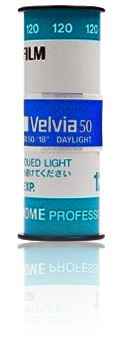
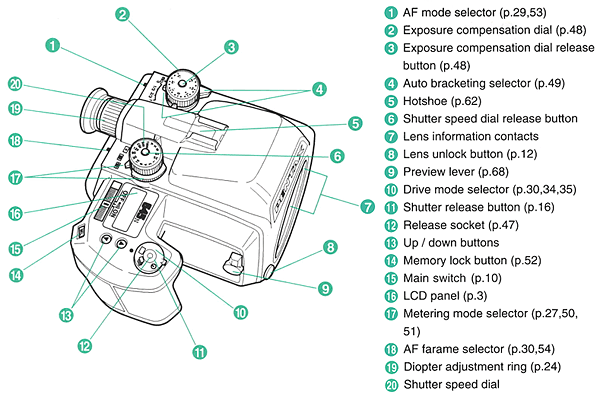
Downloads:
Pentax 645N: specifications
Specs of the Pentax 645N
| Type: | 6×4.5-format autofocus single-lens-reflex camera with multi-mode TTL auto-exposure control. |
|---|---|
| Film: | 1) 120 roll film (16 exposures) 2) 220 roll film (33 exposures) 3) 70mm film (approx. 95 exposures). Film loaded onto interchangeable film holder. |
| Image Size: |
56mm x 41.5mm. |
| Lens Mount: |
Pentax 645 AF mount (interchangeable with Pentax 645 A mount). Applicable lenses: 1) SMC Pentax 645-FA lenses; 2) SMC Pentax 645-A lenses (usable in manual-focus mode only). |
| Exposure Control: |
TTL open-aperture multi-pattern metering. |
| Metering Mode: |
1) Dual six-segment metering; 2) Center-weighted metering; 3) Spot metering. |
| Metering Range: |
EV2 ~ EV21 (at ISO 100 with 75mm f/2.8 lens). Electronic timer with holding time of 10 sec. |
| Exposure Mode: |
1) Programmed AE; 2) Shutter-Priority AE; 3) Aperture-Priority AE; 4) Metered Manual; 5) Bulb. |
| Exposure Compensation: |
±3EV (1/3 EV steps). |
| Memory Lock: |
Activated with ML button. Exposure value memorized for approx. 10 sec. |
| Shutter: | Electronically controlled vertical-run cloth focal-plane shutter. |
| Speed: | 1) Auto: 1/1000 sec. – 30 sec. stepless; 2) Manual: 1/1000 sec. – 4 sec.; 3) X-sync: 1/60 sec.; 4) Bulb; 5) Leaf-shutter lens: 1/8 sec. Shutter locked with main switch off. |
| Viewfinder: | Keplerian telescope viewfinder with interchangeable Natural-Bright-Matte focusing screen (AF Center Spot Matte screen as standard). |
| Field of View: |
92% vertical, 93% horizontal. |
| Magnification: | 0.76X (with 75mm lens at infinity with -1 diopter). |
| Diopter Adjustment Range: |
-3.5 ~ +1.0 diopters. |
| Viewfinder LCD Indication: |
1) Focus indicator; 2) Shutter speed; 3) Aperture; 4) Flash status; 5) Bar graph; 6) Memory lock; 7) Exposure compensation factor; 8) Out-of-exposure coupling range warning; 9) Over- and underexposure indication in Metered Manual. |
| External LCD Indication: |
1) ISO film speed; 2) Exposure count; 3) Film transport status; 4) Battery level; 5) Photographic data imprinting. |
| Film Handling: |
Automatic film advance with built-in motor. Loading: Automatic 1st frame positioning via shutter release button. |
| Advance Mode: |
1) Single-frame advance; 2) Consecutive advance (approx. 2 frames/sec.). Automatic advance to film end after last frame (mid-roll advance to film end possible via mid-roll advance button). |
| Autofocus: | TTL phase-matching autofocus system with focus lock and predictive autofocus. |
| Effective Illumination Range: |
EV-1 ~ EV18 (at ISO 100). |
| AF Frame: |
1) 3-point AF; 2) Spot AF. PCV beep sound for in-focus indication (cancellation possible). |
| Flash Synchronization: |
1) Hotshoe (X-sync contact and dedicated flash contact); 2) X-sync socket. X-sync speed: 1/60 sec. automatically set at recharge completion of dedicated flash unit (X-sync speeds slower than 1/60 sec. can be used in Shutter-Priority AE and Metered Manual). |
| Data Imprinting: |
7-segment dot-matrix data imprinting system. Data imprinted out of image area. |
| Recordable Data: |
1) Exposure frame number; lenses); 3) Shutter speed (Exposure time in Bulb); 4) Aperture; 5) Exposure compensation value; 6) Metering mode 7) Lens focal length (only with SMC Pentax-FA lenses; approximate value for zoom. 8) Data imprinting cancellation (blank mode) available. |
| Self-Timer: | Electronically controlled self-timer with 12-second delay. Mid-operation cancellation possible. |
| Film Speed: |
ISO 6 ~ ISO 6400. |
| Power Source: |
6 AA-size batteries (alkaline or lithium batteries). |
| Battery Life: |
Approximately 130 rolls of 120 roll film; approximately 100 rolls of 220 roll film (under in-house test conditions using alkaline batteries). |
| Multiple Exposure: |
Via multi-exposure switch. |
| Dimensions: | 150(W) x 111(H) x 117(D)mm (5.9″ x 4.4″ x 4.6″) |
| Weight: | 1,280g (45.2 oz) without batteries. |
Pentax 645N: lenses
For the 645N, PENTAX developed five SMC-PENTAX FA autofocus lenses to assure fast, stable autofocus operation. The 645N has perfected the renowned optical system – originally developed for and made famous by the PENTAX 645 – by adding a high-performance viewfinder lupe. As a result, the camera assures comfortable, fatigue-free eye-level shooting over long periods in the field.
 SMC Pentax-FA 645 lenses (autofocus)
SMC Pentax-FA 645 lenses (autofocus)
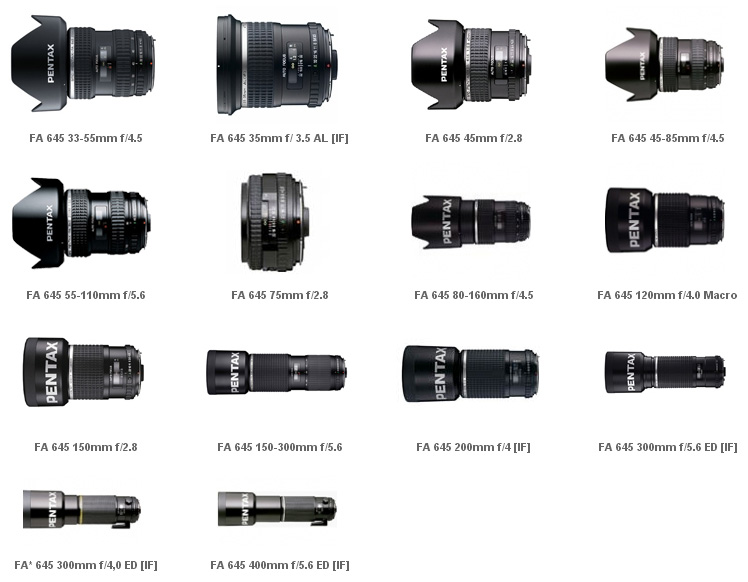
All existing SMC PENTAX-A 645 lenses can be used with the new 645N without any modifications (except for autofocus operation). When using A 645 lenses, the 645N gives both audible and/or visual confirmation — as you manually turn the focusing ring.
SMC Pentax-A 645 lenses (manual focus)
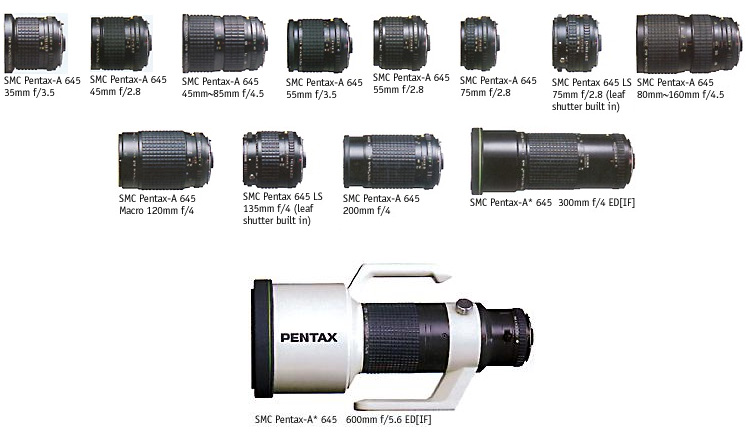
Lens chart
| Lens | AF | Angle of View (°) | groups/ elements | Min. Aperture (f) | Min. Focusing Distance (m) | Filter Size (mm) | Max. Diameter & Length (mm) | Weight (g) |
|---|---|---|---|---|---|---|---|---|
| FA 645 45mm~85mm f/4.5 | |
76 ~ 44.5 | 9 . 11 | 32 | 0.5 | 77 | 85 x 99.5 | 870 |
| A 645 45mm~85mm f/4.5 | – | 76 ~ 44.5 | 9 . 11 | 32 | 0.5 | 77 | 80 x 99.5 | 805 |
| FA 645 Zoom 35mm~55mm f/4.5 | |
93 ~ 65 | 11 . 8 | 32 | 0.5 | 82 | 88 x 104 | 585 |
| FA 645 Zoom 55mm~110mm f/5.6 | |
65 ~ 35 | 9 . 9 | 45 | 0.8 | 82 | 88 x 104 | 500 |
| A 645 80mm~160mm f/4.5 | – | 47 ~ 24.5 | 11 . 11 | 32 | 1 | 77 | 82.5 x 131 | 1,0 |
| FA 645 Zoom 80mm-160mm f/4.5 | 47 – 24.5 | 11 . 10 | 32 | 1.0 | 77 | 85 x 130.5 | 1,0 | |
| FA 645 35mm F3.5 AL [IF] | |
90 | 7 . 10 | 32 | 0.3 | 82 | 88 x 90 | 560 |
| A 645 35mm f/3.5 | – | 90 | 8 . 9 | 22 | 0.3 | 77 | 80 x 67 | 470 |
| FA 645 45mm f/2.8 | |
76 | 8 . 9 | 22 | 0.45 | 67 | 76.5 x 66.5 | 475 |
| A 645 45mm f/2.8 | – | 76 | 8 . 9 | 22 | 0.45 | 67 | 74 x 66.5 | 400 |
| A 645 55mm f/2.8 | – | 65 | 7 . 8 | 22 | 0.45 | 58 | 74 x 60.5 | 410 |
| FA 645 75mm f/2.8 | |
50 | 5 . 6 | 22 | 0.6 | 58 | 74.5 x 37.5 | 215 |
| A 645 75mm f/2.8 | – | 50 | 5 . 6 | 22 | 0.6 | 58 | 74 x 37.5 | 240 |
| A 645 150mm f/32.8 [IF] | |
26 | 7 . 7 | 22 | 1.2 | 67 | 74.5 x 96 | 500 |
| A 645 150mm f/3.5 | – | 26 | 4 . 4 | 32 | 1.4 | 58 | 74 x 71.5 | 435 |
| A 645 200mm f/4 | – | 20 | 4 . 4 | 32 | 2 | 58 | 74 x 116 | 570 |
| FA 645 200mm f/4 [IF] | |
20 | 6 . 5 | 32 | 1.5 | 58 | 74.5 x 119 | 670 |
| FA* 645 300mm f/4 ED | |
13.5 | 8 . 8 | 32 | 3 | 77 | 83 x 207.5 | 1,5 |
| A* 645 300mm f/4 ED [IF] | – | 13.5 | 8 . 8 | 32 | 3 | 77 | 93 x 208 | 1,4 |
| FA 645 300mm f/5.6 ED [IF] | |
13.5 | 7 . 7 | 45 | 2.2 | 67 | 75 x 183.5 | 775 |
| FA 645 400mm f/5.6 ED [IF] | |
10 | 6 . 7 | 45 | 3 | 77 | 83 x 252 | 1,3 |
| A* 645 600mm f/5.6 ED [IF] | – | 6.6 | 11 . 12 | 45 | 5 | 49 | 155.5 x 352.5 | 4,8 |
| A 645 Macro 120mm f/4 | – | 32.5 | 7 . 9 | 32 | 0.39 | 67 | 78.5 x 110 | 695 |
| FA 645 Macro 120mm f/4 | |
32.5 | 9 . 7 | 32 | 0.395 | 67 | 82.5 x 110 | 735 |
| A 645 LS 75mm f/2.8 (leaf shutter) | – | 50 | 5 . 6 | 32 | 0.75 | 58 | 76 x 49.5 | 365 |
| A 645 LS 135mm f/4 (leaf shutter) | – | 29 | 5 . 5 | 32 | 1.25 | 58 | 76 x 69 | 470 |
| Rear Converter A 645 1.4X | – | – | 4 . 5 | – | – | – | 77 x 31 | 265 |
| Rear Converter A 645 1.4X | – | – | 4 . 6 | – | – | – | 77 x 60 | 350 |
Pentax 645N: accessories

AF-330FTZ – With a guide number of 24/119 (at ISO 100/m/ft with a 75mm standard lens) and powered by four AA-size batteries, this flash unit offers 28mm lens coverage, autofocus spot beam, contrast control, auto zoom fuction and second-cutain sync.
AF360FGZ – Guide number (ft/ISO 100) 119, 24mm lens coverage, bounce head. Requires 4 AA batteries.
AF-500FTZ – With a large guide number of 36 (at ISO100/m with a 75mm standard lens), this powerful flash unit features an auto zoom function which changes the angle of discharge according to the lens focal length. It is also equipped to satisfy a diverse range of advanced applications such as bounce flash, trailing-shutter-cutain sync, multiple emission, and slave flash.
AF-140C – Description: A TTL auto flash with a guide number of 14 (ISO 100/m) for shadowless macro flash photography. It has a 360 degree circular flash head that clips-on to the camera lens to provide even illumination for a wide variety of subjects. This macro flash unit has four separate flash tubes. Depending on lighting conditions, the tubes can be manually selected to fire either as one or two pairs, for perfect exposures and three dimentional flash effects. Amodeling light helps improve manual focusing accuracy.


Extension Cord F – 5P – 3′ coiled cord connecting one of the hot shoe adapters (attached to the camera ) directly with the AF-500FTZ flash or to one of the above adapters attached to the bottom of another Pentax flash.
Extension Cord F5P (L) – 9.5′ straight cord connecting one of the hot shoe adapters (attached to the camera) directly with the AF-500FTZ flash or to one of the above adapters attached to the bottom of another Pentax flash.
Hot Shoe Adapter F – For off camera flash with PZ cameras. Mounts to the hot shoe of the camera.
Hotshoe Adapter FG – For off camera flash with PZ and ZX cameras. Mounts to the hot shoe of the camera, and allows the cameras built-in flash to be used as a fill flash.
Off Camera Shoe Adapter F – Mounts to the bottom of the shoe mount on a Pentax flash and contains a tripod mount underneath.
Pentax 645NII
The original Pentax 645 was introduced in 1984. In late 1997 Pentax upgraded it to the 645N and added autofocus capability along with a line of autofocus lenses. In the Fall of 2001 they upgraded this again to the 645NII. Developed as a natural evolution of the 645N, the new 645NII incorporates all its outstanding features and adds several others that further improve performance, handling and ease of use.
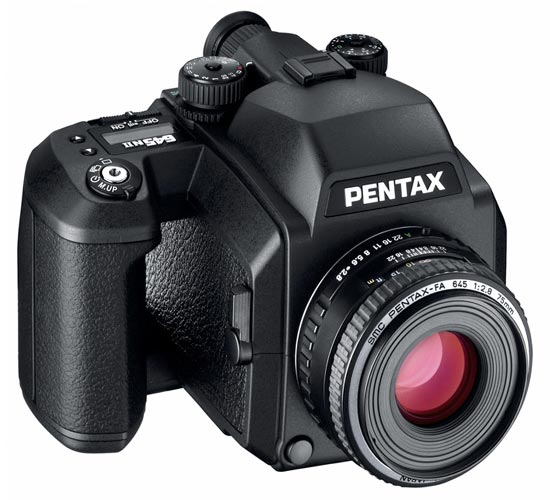
Main new features of Pentax 645NII
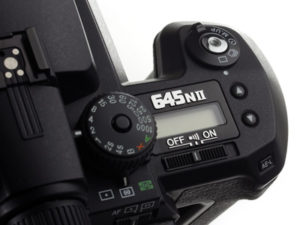 Smooth Mirror Operation with Lock-Up Mechanism to Minimize Camera Shake
Smooth Mirror Operation with Lock-Up Mechanism to Minimize Camera Shake
The 645NII features an upgraded mirror mechanism that swings the mirror up and down more smoothly and silently than its predecessors, generating far less jolt at shutter release and greatly reducing camera shake during exposure. It also comes equipped with a mirror lock-up mechanism to effectively minimize camera shake at the crucial moment of shutter release — a feature particularly useful when using telephoto and super-telephoto lenses, where image quality can be affected by the slightest vibration.
Pentax Functions to Customize Camera Operation to User Preference
Ten different PENTAX Functions help you fine-tune the 645NII. For instance, you can preprogram shutter-speed step (1/2EV or 1EV), exposure-compensation step (1/3EV or 1/2EV) and the availability of program shift (prohibited or permitted) to suit your operational preference and shooting style.
Data Imprinting Function to Preserve Photographic Data Permanently
The 645NII‘s on-the-film data imprinting function lets you save valuable photographic data permanently for future reference by automatically recording as many as 17 different types of data onto the blank space outside the image area.
Release Socket Compatible with Cable Switches and Release Timer Switch
The 645NII‘s release socket not only offers solid connection with the optional CS-105 and CS-130 cable switches and TS-110 release timer switch, but also allows single-action attachment and removal of these accessories. The cable switches can be used to minimize camera shake at shutter release — especially during extended exposures in the Bulb mode — while the release timer switch simplifies interval shooting by allowing you to preset starting time, the interval between exposures and exposure duration.
Other Outstanding Features
- High-precision autofocus system, with a choice of 3-point wide-area AF and spot AF
- Multi-mode metering system, with a choice of dual 6-segment metering, center-weighted metering and spot metering
- User-friendly operation with effortless dial/lever control
- Auto bracketing to capture the subject at three different exposure levels (proper/under/over)
- High-speed film winder to advance the film at approximately two frames per second
- AE lock to memorize an exposure value before recomposing the image
- A choice of four interchangeable Natural-Bright-Matte focusing screens.
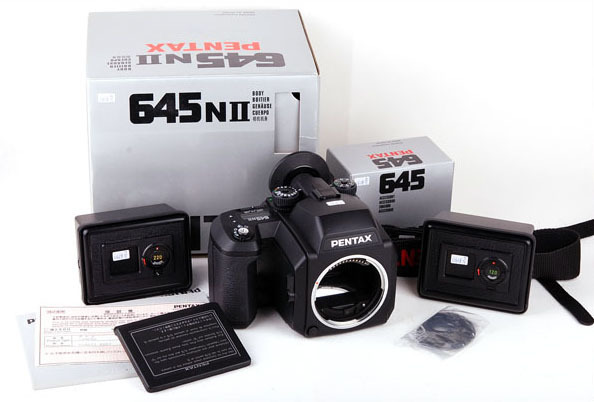
Comparison between the Pentax 645, 645N, and 645N II
source: Pentaxforums
| Pentax 645 | Pentax 645N | Pentax 645N II | |
|---|---|---|---|
| Year introduced | 1984 | 1997 | 2001 |
| Mount | Pentax 645 A | Pentax 645 AF | Pentax 645 AF |
| Meter range | 3 – 19 EV | 2 – 21 EV | 2 – 21 EV |
| Meter pattern | center-weighted | m (6 segment) c s | m (6 segment) c s |
| ISO range | 6 – 6400 | 12-6400 | 12-6400 |
| Film type | 120 and 220 roll film, 70mm film | 120 and 220 roll film, 70mm film | 120 and 220 roll film, 70mm film |
| No. of exposures | 120 film: 15, 220 film: 32, 70mm: 90 | 120 film: 16, 220 film: 33, 70mm: 95 | 120 film: 16, 220 film: 33, 70mm: 95 |
| Data imprint on film | No | Yes | Yes |
| Exposure modes | P, Tv, Av, M, B, X | P, Tv, Av, M, B, X | P, Tv, Av, M, B, X |
| Exposure compensation | +/-3 EV | +/- 3 EV | +/- 3.3 EV |
| Exposure memory lock | No | Yes | Yes |
| Shutter speeds (auto) | 15 – 1/1000s | 30 – 1/1000s | 30 – 1/1000s |
| Shutter speeds (manual) | 15 – 1/1000s | 4 – 1/1000s, B | 6 – 1/1000s, B |
| Shutter speeds (mechanical) | None | None | None |
| Half step speeds in M and Tv | No | No | Yes |
| Self timer | No | Yes | Yes |
| Mirror lock-up | No | No | Yes |
| Auto bracketing | No | Yes | Yes |
| Multiple exposures | Yes | Yes | Yes |
| Winder | Built-in, 1.5 fps | Built-in, 2 fps | Built-in, 2 fps |
| Built-in flash | No | No | No |
| TTL flash | Yes | Yes | Yes |
| P-TTL flash | No | No | No |
| Sync speed | 1/60s | 1/60s | 1/60s |
| Flash exposure comp | No | No | No |
| Autofocus | No | Yes, (3 points) | Yes, (3 points) |
| Autofocus sensitivity | Not applicable | -1 – 18 EV | -1 – 18 EV |
| Viewfinder | 0.75x, 92% (vert), 93% (hor) | 0.76x, 92% (vert), 93% (hor) | 0.76x, 92% (vert), 93% (hor) |
| Viewfinder type | Keplerian telescope | Keplerian telescope | Keplerian telescope |
| Diopter correction | -5 – +2 | -3.5 – +1.5 | -3.5 – +1.5 |
| Exchangeable screen | Yes | Yes | Yes |
| Depth of field preview | Yes | Yes | Yes |
| Image size | 41.5 x 56 mm | 41.5 x 56 mm | 41.5 x 56 mm |
| Battery | 6 x AA | 6 x AA | 6 x AA |
| External battery pack | No | Yes | Yes |
| Size (W x H x D) | 147 x 109 x 117 mm | 147 x 109 x 117 mm | 147 x 109 x 117 mm |
| Weight | 1320 g | 1280 g | 1280 g |
| Comment | Accepts leaf shutter lens for flash synchronization to 1/500s. Accessories: 120 and 220 film backs, 70mm film holder | Accepts leaf shutter lens for flash synchronization to 1/500s. Accessories: 120 and 220 film backs, 70mm film holder. External battery pack | Accepts leaf shutter lens for flash synchronization to 1/500s. Accessories: 120 and 220 film backs, 70mm film holder. External battery pack |
Copyright, Authorship, and Ownership statements
All text and images are copyright ©️ Chrysis.net unless otherwise stated - please see individual cases for authorship and copyright details. The specimens pictured are from the authors' or other collaborators' personal collections and from the collections of various museums. Unless otherwise specified, the whole content of this web site is for personal, non-commercial, scientific, and educational purposes given proper accreditation to the page from which they were derived are provided, and under Chrysis.net Terms and Conditions.
For citation purposes
Agnoli G.L. (2025) A tribute to the Pentax 645N and Pentax 645NII, in: Chrysis.net website. Interim version 23 April 2025, URL: https://www.chrysis.net/photography/pentax-645n/.

